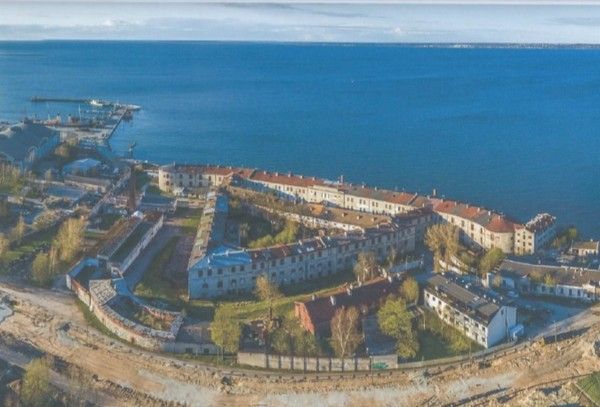The objective is to conserve, restore, develop and put into use the Patarei sea fort and its site on the outskirts of Tallinn.
The Patarei fort was completed in 1840. Later it was converted to a military barracks and from 1920 into a prison, from which it gained notoriety during the Soviet and Nazi occupations. The complex by its location, architectural uniqueness and history is an exceptional heritage both nationally and for the wider Baltic region. It is a protected monument under Estonian Law but despite this it has been neglected since 2005 and is now badly degraded and virtually abandoned.
The Authorities are proposing to sell the whole complex to the private sector which will be responsible for its development under a Zoning Plan. This Zoning Plan, currently being finalised, implicitly retains the main fort buildings, the “heritage” components, and allows further new developments on the site, within certain limits. Meanwhile the Authorities have commissioned an outline development for the site which has been used as an example, awaiting new proposals.
While accepting the idea for some new developments of multi-functional use on the site so as to facilitate the restoration works, serious concerns exist on many levels, notably:
There is very little detailed information available, or has been made available by the Authorities, which suggests that the project is not yet adequately prepared for public tendering.
The main concern is that the proposed sale to a private sector developer may well not succeed as a commercial proposition in view of the responsibility and risks associated with restoring the “heritage” components. Thus either the sale will not attract interest from suitable developers or the developer may delay or omit restoring the heritage components, concentrating instead on the more lucrative new buildings. Both outcomes would be unsatisfactory. It is indicative that the Authorities’ agent managing the sale process is the State Real Estate Ltd, whose expertise is in real estate.
A key unknown is the detailed state of the buildings to be restored and the costs and their use potential. The most recent technical survey dates from 2005 and identified major problems of water infiltration. The restoration costs are roughly estimated at 65 M €. Also unknown and awaiting the proposals is the scope of the new constructions . These could comprise apartment dwellings, car parking, office and small business space, recreation and restauration, maybe museums or a hotel. Their cost might be about 45 M €. The total cost could be about 110 M €, phased over several years.
Some detailed concerns exist on the restoration of the existing buildings as well as the protection of the site which need special attention to retain its heritage character.
The financial viability of the whole development for the private sector is very doubtful without a large injection of equity or grant. This is because of the high comparative cost and lower revenue potential of the heritage components which out-weigh the more profitable new developments.
If the Authorities wish to proceed with the sale then a number of essential safeguards should be introduced into the contract or acted upon being summarised as follows:
Ensure contractually that the appropriate restoration of the “heritage” components proceeds in line with the other developments.
Introduce some mechanism to approve the final design proposals so that the Zoning Plan criteria are respected and also that a coherent balanced development results.
It is recommended to undertake a new technical survey and preliminary cost estimates of the restoration works prior to tender. This would help reduce the risk for all parties.
It is recommended to establish a “Steering Committee” to oversee the strategic progress of the development and to include all the relevant Authorities as well as representative NGOs. Lack of transparency with the public and the exclusion of contributions from responsible experienced NGOs have been weaknesses in the past and an on-going concern.
It is suggested to have a pre-selection stage in any tender process. This would not only screen candidates but test the potential interest prior to launching a full tender.
The preferred option would be to retain overall control by the Authorities and to undertake further preparation in investigations and studies before implementation.
The first action would be to undertake the essential further studies which are necessary to define and prepare any development. These, in addition to the technical study cited above, should include market studies into potential uses of the facilities (dwellings, car parking, offices, workshops, restaurants, hotels, museums), and a strategic study on how to develop the various components, with the assistance of the private sector as appropriate. In parallel the essential and urgent roof repairs should be carried out as soon as possible.
The key issue in any option is finance.The overall cost could be above 100 M € for the full development as currently proposed, spread over several years. Most of the new constructions could be self-financed but due to the heritage restoration obligation, the overall financial equilibrium almost certainly requires a substantial equity or grant contribution. Equity could be available from a private developer (but unlikely in view of the risks) and grant assistance could be available from the EU. Extra funds from Government or elsewhere may be required to complete the financing. A further study into financing options is necessary once the outline costs and the strategy have been firmed up and this would be an iterative process.
In summary:
This complex is an important heritage asset, in need of urgent attention.
The outline proposals may need adjustments and some additional studies.
However the proposed sale is considered unviable and with undue risk and this should be reviewed critically before proceeding further.
An alternative approach is proposed with more preparation and with overall control retained by the Authorities.
Finance will be a problem for any option, with significant grants required.Full report
